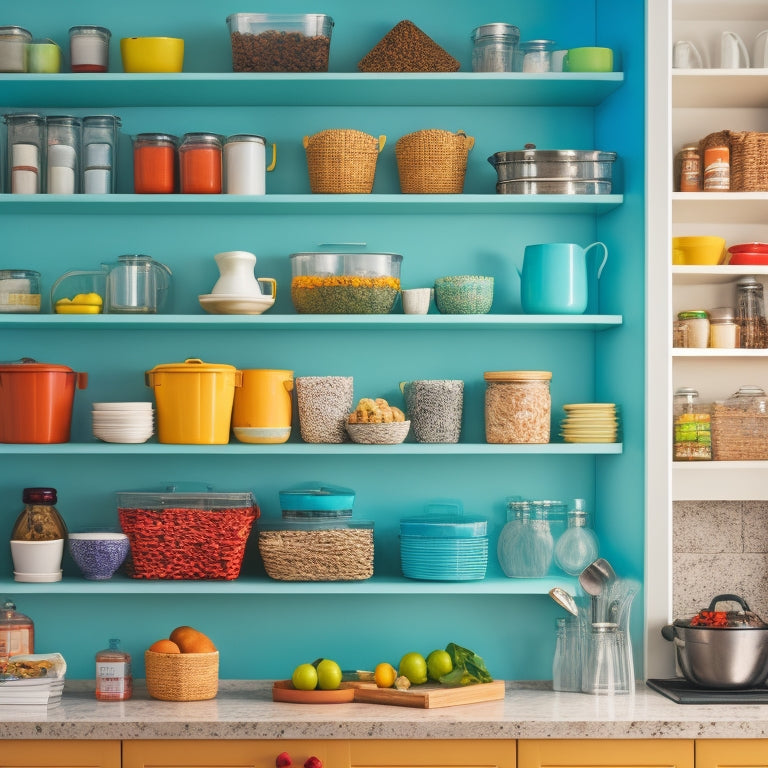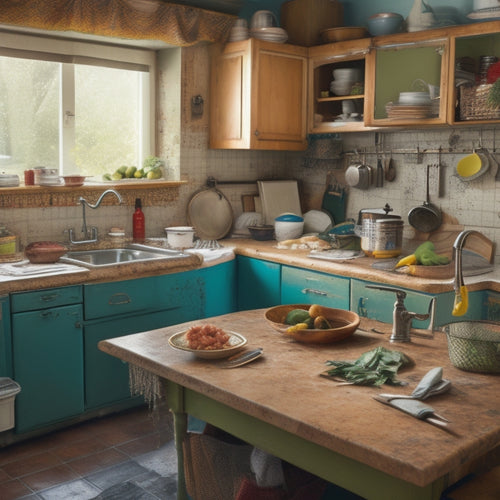
Revamp Your Kitchen: Tips for Decluttering Efficiently
Share
You're tired of a cluttered kitchen, where countertops are overwhelmed with utensils, appliances, and miscellaneous items, making meal prep a frustrating experience. To revamp your kitchen, start by clearing everything off your counters and sorting items into categories. Prioritize counter space utilization and optimize efficient storage. Focus on utensil organization, under-sink storage, and decluttering pots and pans. Simplify your cooking routine, remove unused items, and utilize pantry organization systems. By doing so, you'll create a more streamlined kitchen. Now, discover how to take your kitchen to the next level with our expert tips and tricks.
Key Takeaways
• Clear everything off kitchen counters to sort items into categories, prioritize space utilization, and optimize efficient storage.
• Remove unused utensils, use adjustable drawer dividers, and prioritize frequently used utensils for accessibility and simplicity.
• Purge expired cleaning supplies, organize remaining items into bins, and install slide-out drawers or shelves for under-sink storage.
• Evaluate cookware collections, remove unnecessary items, and organize remaining pots and pans in a logical and accessible way.
• Digitize recipes, consolidate plastic storage containers, and declutter cookbooks to create a streamlined kitchen with minimal clutter.
Kitchen Counter Revamp
Revamping your kitchen counter starts with recognizing that countertops are for food preparation, not storage. So, begin by clearing everything off your counters and sorting items into categories to identify what can be stored elsewhere. This will help you prioritize your counter space utilization and optimize efficient storage.
By doing so, you'll achieve clutter-free countertops that allow you to focus on meal prep. Be honest with yourself - do you really need that blender or coffee maker taking up valuable space? Consider storing bulky items like Crock Pots in cabinets or on high shelves.
Utensil Organization Essentials
You'll be amazed at how a clutter-free utensil drawer can simplify your cooking routine and reduce stress in the kitchen.
To achieve this, focus on utensil curation by removing unused or duplicate items. Consider using adjustable drawer dividers to create separate compartments for different types of utensils. This will enable you to locate the right tool quickly, boosting organizational efficiency.
By prioritizing frequently used utensils, you'll save time and energy. A well-organized utensil drawer also promotes utensil accessibility, allowing you to grab what you need in a flash.
With a clutter-free space, you'll be more productive and enjoy a more streamlined cooking experience.
Under-Sink Storage Solutions
To maximize the often-wasted space under your sink, start by purging expired or unused cleaning supplies and organizing the remaining items into bins or containers. This will help you tackle sink clutter and create a more efficient cleaning station.
| Under-Sink Organization Tips | Benefits |
|---|---|
| Use bin organization for cleaning supplies | Easy access to frequently used items |
| Implement child-friendly solutions | Prevents accidental exposure to harsh chemicals |
| Install a slide-out drawer or shelf | Increases storage capacity and visibility |
| Maintain a clutter-free space under the sink | Reduces stress and saves time |
Pots and Pans Decluttering
Now that you've optimized your under-sink storage, turn your attention to another often-cluttered area: your pots and pans collection.
It's time for a cookware evaluation. Begin by removing all pots and pans from your cabinets and evaluating each item. Be honest with yourself – do you really need that extra frying pan or is it just taking up valuable space? Consider the frequency of use and the condition of each piece. If you haven't used it in the past year, it's likely safe to let it go.
Once you've purged your collection, organize the remaining items in a logical and accessible way. Store frequently used pots and pans in easy-to-reach locations, and consider pantry organization systems to maximize storage space.
Container and Cookbook Clarity
Every kitchen has a stash of plastic storage containers, but it's time to evaluate which ones are truly essential and deserving of precious cabinet space. Start by sorting through your containers, and get rid of any that are broken, missing lids, or no longer useful. This Tupperware purge will help you identify what you really need.
Next, consider container consolidation by grouping similar items together and storing them in a designated area. This will free up space and reduce clutter.
Now, turn your attention to your cookbooks. Digitize your favorite recipes and consider donating or decluttering cookbooks that no longer inspire you. By doing so, you'll create a more streamlined kitchen with easy access to the recipes and containers you need.
Kitchen Surface Simplification
You've streamlined your containers and cookbooks, and now it's time to turn your attention to the surfaces where meal prep magic happens: your kitchen counters. Simplifying and decluttering these areas is crucial to create a more efficient and organized kitchen.
| Surface Simplification Tips | Benefits |
|---|---|
| Clear off countertops | More room for meal prep |
| Install a spice rack | Convenient access to frequently used spices |
| Manage fridge magnets | Decreased clutter and visual distractions |
| Designate a mail area | Minimized counter chaos |
| Organize utensil drawers | Quicker access to necessary tools |
Appliance and Accessory Optimization
Take control of your kitchen's appliance and accessory landscape by reassessing what's essential and what's unnecessary, and then strategically storing or removing items to maximize functionality and free up valuable space. This will help you create a more efficient and organized kitchen.
Some areas to focus on include:
-
Gadget storage: Designate a specific area for infrequently used gadgets, such as a high cabinet or a designated drawer, to keep them out of the way but still accessible.
-
Accessory arrangement: Organize your accessories, like utensils and cookware, in a way that makes sense for your cooking habits and the layout of your kitchen.
-
Countertop optimization: Leave only the most essential appliances and accessories on your countertops, and consider installing an appliance garage or a utensil organizer to keep them tidy.
Frequently Asked Questions
How Do I Maintain My Kitchen's Organization Over Time?
To maintain your kitchen's organization over time, prioritize time management by creating kitchen routines, utilizing storage solutions like labels and bins, and following maintenance tips like regular decluttering and cleaning schedules.
Can I Customize My Kitchen Organization to Fit My Personal Style?
Imagine your kitchen as a canvas, where you're the artist, painting a masterpiece of personalized storage and decorative organization. You craft a space that reflects your style, with bespoke solutions that make meal prep a breeze.
What Are Some Eco-Friendly Kitchen Organization Options Available?
You can incorporate eco-friendly kitchen organization options by opting for sustainable solutions like repurposed containers, reclaimed wood shelves, and energy-efficient appliances, embracing a green organizing approach that reduces waste and conserves resources.
How Can I Involve My Family in the Kitchen Organization Process?
'Embark on a kitchen organization adventure like a skilled chef following a recipe, and invite your family to join the culinary quest, fostering teamwork and shared responsibility in the decluttering process.'
Are There Any Kitchen Organization Apps or Tools That Can Help?
You can utilize kitchen organization apps and tools like StillTasty for a virtual pantry, or Shelf for smart storage, to streamline your kitchen decluttering process, making it easier to maintain your newly organized space.
Related Posts
-

Why Kitchen Renovation Demands a Meal Planning Strategy
As you prep for your kitchen renovation, you'll quickly realize that the absence of a meal planning strategy is a rec...
